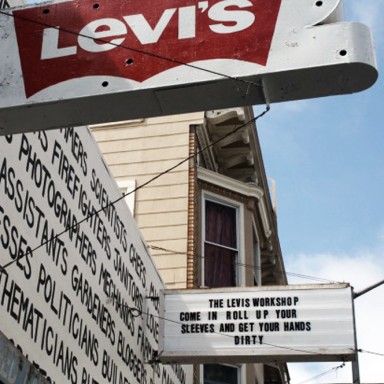Originally published in Mission Loc@l, July 2010
1. “Come in. Roll up your sleeves. Get your hands dirty,” says the sign outside of the Levi’s Workshop on Valencia.
2. Inside, nothing is dirty. It looks something like a print studio, but a print studio in the hands of a set designer. The pump bottle of Gojo hand cleaner is immaculate, and perfectly complements the bundle of twine a few feet away. The printing presses are labeled like museum exhibits. In the center of the room, two men with very large cameras are busily taking photographs of Alice Waters.
3. This is the story: Levi’s is launching a new line of work wear. Among its offerings: trucker jacket ($89.50). Chambray work shirt ($79.50). They hired Weiden + Kennedy, an advertising agency based in Portland, Oregon, and Weiden + Kennedy came up with this slogan: “We are all Workers.” They rented vacant retail space owned by Charles Phan, owner of the Slanted Door. Because the Levi’s workshop is open for only two weeks, they were able to circumvent the hearing process that chain stores are typically subjected to before renting commercial space in the Mission. Pants will be sold, but the proceeds will go to the nonprofits that are co-hosting the workshop events.
4. Among the offerings at the Levi’s store: free carpenter’s pencils in red, white and blue, printed with the messages “We are all Workers” and “Ready to Work.”
5. 104 years ago and two blocks away, Levi’s opened a three-story factory at 14th and Valencia. A crowd stood around the building at the opening, applauding. It was 1906. Most of San Francisco was still in ruins from the earthquake earlier that year.
6. When that factory closed in 2002, only 100 employees were still working there. Manufacturing had moved to Asia, and only the most expensive jeans in the Levi’s line were still sewn on site. Like replicas of the Nevada jeans — a pair of ancient Levi’s discovered in a Nevada mining town and sold back to the company, on eBay, for $46,532. Their design was one that the company no longer had any record of — lost technology, destroyed in the quake.
7. The San Francisco Chronicle quoted Levi’s CEO Philip Marineau as saying that the closure was “hard in the sense that there are emotions associated with that history. The pure economics weren’t so difficult.” This was, the article said, Levi’s attempt to “right its troubled finances by becoming less of a jeans maker and more of a jeans marketer.”
8. But selling jeans requires emotions in a way that making them does not. And so, at Weiden + Kennedy’s suggestion, the models in the advertisements for Levi’s new workwear line are all residents of a city called Braddock, Pennsylvania. Many of them are unemployed.
9. Braddock is an interesting place. It was the site of Andrew Carnegie’s first steel mill and Andrew Carnegie’s first library. It has done about as well as one would expect of a steelworking town in a country that no longer makes steel, which is to say: not well. Since the 1950s, Braddock has lost over 90 percent of its population. In 2005, Braddock gained a hip mayor with master’s degree in public policy and economics from Harvard. His name is John Fetterman. He arrived in 2001 as an Americorps volunteer. He now has Braddock’s zip code tattooed on his left arm.
10. Fetterman’s plan to refurbish Braddock? Marketing. One of the first things that he did as mayor was to put up an edgy website advertising the town. “Destruction Breeds Creation. Create Amidst Destruction” is spelled out in bold capitals on the front page. There is a section with blurry black-and-white Polaroid photos of abandoned buildings.
11. Fetterman has offered free studio space to artists who agree to move there. He’s turned the old church into a community center that hosts avant-garde events and all-night dance parties. Fetterman is pitching Braddock as an ideal location for startups. “An unparalleled opportunity,” as the website says, “for the urban pioneer, artist, or misfit.”
12. It could be argued that Fetterman is trying to replicate in Braddock what happened in the Mission — a working-class, industrial neighborhood that is well into its transformation into a place that doesn’t make much except for ideas, and exceptionally good coffee. The theory has often been floated that urban pioneers, artists and misfits are integral to transformations like these.
13. Levi’s reports that it will be giving the town of Braddock more than a million dollars, plus some help with its urban farming program, in exchange for becoming its poster town. San Francisco gets donations for nonprofits like the Edible Schoolyard and printmaking workshops. What neither city is going to get much of from Levi’s, though, is a job that lasts longer than a few weeks.
14. “It’s great to be able to work full-time as a printmaker,” says Rocket Caleshu, normally employed by the San Francisco Center for the Book, one of the nonprofits involved with the workshop. “Those jobs are hard to come by.” Caleshu is working three jobs at the moment, she said.
15. It almost goes without saying, but every local person temporarily employed by the Levi’s Workshop comes across as fully aware of the strangeness of their circumstances — temporary workers, in a manicured environment. A young worker motions me over and says, sotto voce: “All of these ads say, ‘We are all Workers.’ Look at this,” she says, pulling back the waistband of a pair of work jeans ($97.50) to reveal the label, “Made in Cambodia.”
She looks so earnest, as though she is discovering this for the first time. “Where,” she says, “am I supposed to go to do this work?”
